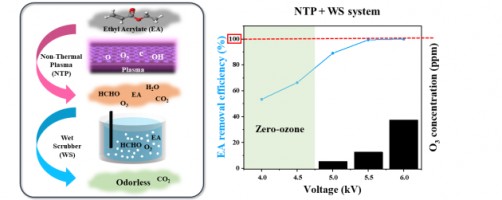Newswise — The Korea Institute of Industrial Technology (KITECH) announced that Dr. Suhan Kim's team has developed a green technology for eliminating odorous volatile organic compounds (VOCs) and their by-products, such as residual ozone and formaldehyde.
VOCs are gases emitted from certain solids or liquids, comprising a wide range of chemicals that can deteriorate the quality of life and impact human health. VOCs are found in various household, industrial, and commercial products. However, their accumulation in air and water has primarily garnered attention due to the associated health risks.
The research led by Dr. Suhan Kim introduces a fuel-free technology for removing VOCs designed to replace incineration methods like thermal oxidizers and regenerative thermal oxidizers. This technology merges non-thermal plasma (NTP) with a wet scrubber (WS) system. Specifically, it employs atmospheric non-thermal plasma (ANTP) to enhance the scrubber's VOC removal efficiency from 33% to 99.9% while minimizing the ozone generation typically produced by plasma.
NTP treatment stands out as a highly effective method for addressing odorous VOCs due to the production of high-energy electrons. These electrons destroy the structures of odorous gases and generate abundant radicals, which can be oxidized to CO2 and H2O, thereby increasing the reaction rate.
Furthermore, WS is frequently utilized to remove odorous gases due to their relatively low cost and ease of handling. They have also been the subject of extensive research aimed at enhancing their economic viability and capacity for treating odorous gases.
Notably, this research introduces a process technology for removing VOCs that does not burn fuel, such as LNG, unlike conventional methods. As a result, it does not emit carbon dioxide through incineration. When implemented in industrial exhaust gas treatment facilities, both installation and operating costs are lower compared to those of the incineration method.
Compared to the separate use of NTP and WS, integrating a WS after NTP alters the kinetic characteristics and distribution of active particles, thereby improving the degradation efficiency of odorous VOCs. Additionally, the combined NTP and WS system can minimize or eliminate secondary air pollution by capturing ozone and other gaseous intermediate organics, which are by-products of the NTP process.
Because the NTP and WS system does not rely on chemicals or catalysts and eliminates the need for additional equipment to remove ozone, the total cost of the system, covering both installation and operation, can be reduced.
"EA was selected as a representative for odorous VOCs because of its toxicity and the irritating, unpleasant smell it emits. Our observations indicate that the removal efficiency within the NTP and WS system exceeds the VOC concentrations usually present in process gases from chemical facilities. Furthermore, we envision that this combined NTP and WS system could be implemented in many industries as an effective gas treatment method that does not produce ozone and requires lower energy consumption," explained Dr. Suhan Kim of KITECH.
###
This research was supported by KITECH as part of the project "Development of eco-friendly production system technology for total periodic resource cycle (KITECH EO-22-0007)" and published in the articles of Chemosphere (IF=8.8, 2022), Aug. 2023.
KITECH, founded in 1989 as an affiliate of the Ministry of Commerce and Industry, has emerged as a premier comprehensive applied research institute in Korea. KITECH is addressing the digital transformation challenges confronting local industries, both internally and externally, by leading the charge in supporting Korean manufacturing innovation globally.

